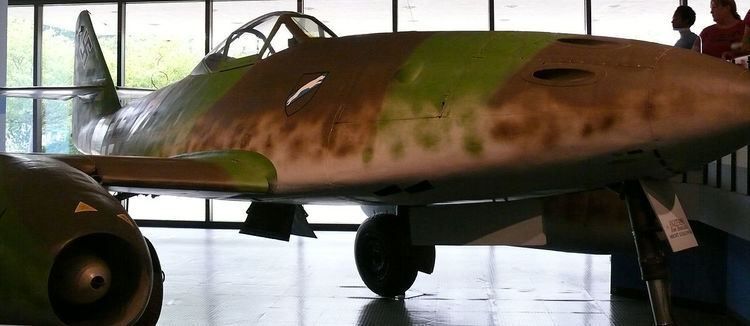Active 1944–45 Role Air superiority | Size Air Force Wing | |
 | ||
Jagdgeschwader 7 (JG 7) Nowotny was a Luftwaffe fighter wing during World War II and the first operational jet fighter unit in the world. It was created late in 1944 and served until the end of the war in May 1945, and it operated the Messerschmitt Me 262 jet fighter exclusively.
Contents
Background
JG 7 was formed under the command of Oberst Johannes Steinhoff, with Kommando Nowotny (the initial Me 262 test wing ) renumbered III./JG 7. Under the command of Major Erich Hohagen III./JG 7 was the only element of JG 7 ready to operate against the Allies. Throughout its existence JG 7 suffered from an irregular supply of new aircraft, fuel and spares. With such a radically new aircraft, training accidents were also common, with 10 Me 262s being lost in six weeks.
The technical troubles and material shortages meant initial tentative sorties were only in flight strength, usually no more than 4 or 6 aircraft. Flying from Brandenburg-Briest, Oranienburg and Parchim, the Geschwader flew intermittently against the USAAF bomber formations. On 3 February JG 7 intercepted USAAF bomber formations and 5 bombers were claimed shot down.
By the end of February 1945 JG 7 had claimed around 45 four-engined bombers and 15 fighters, but at this stage of war this success rate had no effect whatsoever on the Allied air offensive.
During March JG 7 began to deliver larger scale attacks against the Allied bombers. 3 March saw 29 sorties for 8 kills claimed (one jet was lost). On 18 March III./JG 7 conducted their biggest attack numerically thus far, some 37 Me 262s engaging a force of 1,200 American bombers and 600 fighters. This action also marked the first use of the new, unguided R4M rockets. 12 bombers and 1 fighter were claimed for the loss of 3 Me 262s.
The total numbers of aircraft shot down by JG 7 is difficult to quantify due to the loss of Luftwaffe records; between 136 and 420 Allied aircraft may have been claimed shot down.
March 1945
About 20 Me 262s of I. Gruppe and 7 of III. Gruppe took off during the early morning to intercept 460 RAF and RCAF Lancasters and Halifaxes bombing Hamburg, (including the RCAF units of No. 419 Squadron (Moose), No. 434 Squadron (Bluenose), No. 408 Squadron (Goose), No. 415 Squadron (Swordfish) and No. 425 Squadron (Alouette)).
Oberleutnant Sturm, Oberleutnant Hans Grünberg (2), Leutnant Todt (2), Leutnant Schenk (2), Oberleutnant Franz Schall (2), Fähnrich Ehrig (2), Leutnant Hans-Dieter Weihs (1 probable) and Flieger Gerhard Reiher had achieved 13 aerial victories without loss.
The days victory total was raised by at least six during the afternoon when Oberleutnant Stehle led a formation against one of the numerous Lancaster formations. The Staffelkapitän of 2./JG 7 Fritz Stehle shot down a Lancaster near Osnabrück. 11. Staffel and the Stabsschwarm engaged the 8th Air Force in the Zeitz, Brandenburg and Braunschweig areas. American records show the loss of 3 B-17s, 2 B-24s and 4 P-51s mostly to Me 262s. It is believed that Major Weissenberger, Oberfähnrich Windisch and Oberfeldwebel Pritzl each destroyed a B-17. Major Ehrler and Leutnant Rudolf Rademacher probably accounted for a Mustang each.
April 1945
On 7 April JG 7 flew 59 sorties, the largest number in one day, though most failed to engage the Allies. The jets claimed five Allied aircraft destroyed for the loss of two of their own.
On 7 April 1945 elements of III./JG 7 and I.(J)/KG 54 (totaling some 60 ME262s) were sent to intercept the fighter escorts accompanying 1,261 bombers over Northern Germany, while the 180-strong fighter formation of Sonderkommando Elbe attacked the bomber forces. The jets claimed some 18 victories but over 60 of the Bf 109 force was destroyed along with 27 Me 262s almost half of those committed. Some 19 pilots were killed or missing, while five were wounded. U.S. losses from all causes were 19 bombers and 8 escort fighters.
May 1945
At 16:00 on 8 May 1945 fighters of the JG 7 fought the last aerial battle of World War II in Europe. At about 15:20 Oberleutnant Fritz Stehle and his wingman took off on Me 262 to intercept Soviet Yak-9 fighters and came upon the surprised enemy over Freiberg. Stehe claimed a Yak-9 but the plane shot down was probably an Airacobra. Actually Soviet records show that two P-39 - piloted by M.Lt Sergey Stepanov of 129 GIAP and Aleksey Ivanyuk of 152 GIAP - had been lost. Stehle's victory was anyway the last aerial victory by a German fighter pilot in World War II.
